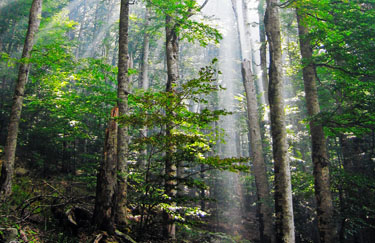Protecting Europe's last, old-growth forests
 Forest,
Forest,  Preservation
Preservation  Virgin beech forest in Biogradska Gora, Montenegro. Credit, Snežana Trifunović.Whenever I think of old-growth forests, I envision the redwoods of Northern California or the Amazon region of South America - not the continent of Europe where forest destruction and intensive management have been widespread for millennia. However, in parts of Europe, areas of virgin forest still exist - mostly in Russia, but also in other countries, as well.
Virgin beech forest in Biogradska Gora, Montenegro. Credit, Snežana Trifunović.Whenever I think of old-growth forests, I envision the redwoods of Northern California or the Amazon region of South America - not the continent of Europe where forest destruction and intensive management have been widespread for millennia. However, in parts of Europe, areas of virgin forest still exist - mostly in Russia, but also in other countries, as well.
A new study in the journal Biodiversity and Conservation reflects a growing effort to identify and protect these remnant old-growth forests. Peter Veen and fellow researchers conducted an inventory of virgin forests in the countries of Romania and Bulgaria.
The extent and exact location of old-growth forest in Romania, Bulgaria and other countries of Europe have been unknown. The results from the inventory have helped inform the pre-accession process of both countries as they enter the European Union.
As part of the process, Romania and Bulgaria will be protecting 80% and 97% of their remaining old-growth forests respectively. Protecting the few remaining old growth forests of Europe is important not just for preserving their biodiversity values but also for maintaining a scientific reference of what these original forests were like.
To identify these areas, the researchers used criteria on what merits the designation "old-growth." The idea of virgin forest is typically associated with very old and large tress. While this is certainly a factor, other criteria were used such as the presence of native trees, the absence of elements of past human disturbance, the occurrence of dead wood, a minimum size area, etc.
The researchers applied these criteria to existing forests using a combination of satellite imagery, field work, and historical research. In Romania, they identified 3402 old-growth forest sites totaling 218,494 hectares - largely dominated by European beech. Meanwhile in Bulgaria, they inventoried 160 virgin forest areas totaling 103,356 hectares with European beech and Oriental beech as the prevailing forest types.
These acreage figures are much larger than I would have expected. However, the acreage per old-growth area is obviously small - particularly in Romania. Because of this, the researchers recommend that future preservation efforts in Romania focus on protecting "a network of functional bio-corridors between adjacent virgin forest sites."
This research project in Romania and Bulgaria provides a good model for other nations in Eastern and Central Europe. The authors write,
"The achieved results give an impetus to start similar inventory programs in all countries, to come to a complete survey of remaining virgin forests in whole temperate Europe."
--Reviewed by Rob Goldstein
Veen, P., Fanta, J., Raev, I., Biriş, I., Smidt, J., & Maes, B. (2010). Virgin forests in Romania and Bulgaria: results of two national inventory projects and their implications for protection Biodiversity and Conservation DOI: 10.1007/s10531-010-9804-2




Reader Comments